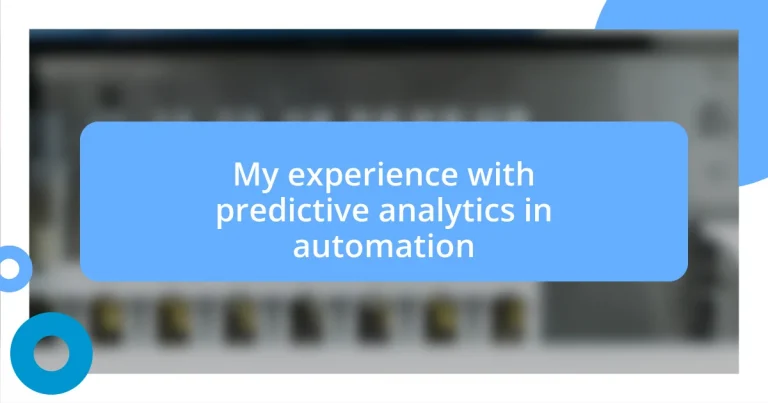Key takeaways:
- Predictive analytics transforms uncertainty into informed decision-making, allowing businesses to anticipate customer needs and enhance operational efficiency.
- Implementation challenges include data silos, skill gaps, resistance to change, high costs, and unclear objectives, highlighting the need for collaboration and clear goals.
- Real-world applications, such as customer churn prediction and improved inventory management, showcase the tangible benefits of predictive analytics, boosting customer satisfaction and team morale.

Understanding predictive analytics
Predictive analytics is a fascinating blend of statistics, data mining, and machine learning aimed at forecasting future outcomes based on historical data. I remember the first time I encountered it while working on a project that aimed to optimize supply chain processes. The thrill of uncovering patterns hidden in vast data sets felt like discovering a new universe of possibilities.
In my experience, the real magic of predictive analytics lies in its ability to turn uncertainty into informed decision-making. I often wondered, how can we navigate complex business challenges more effectively? Well, by leveraging past behaviors and trends, businesses can anticipate future customer needs and improve operational efficiencies. It’s like having a roadmap that guides decisions, reducing guesswork and maximizing resources.
Moreover, what struck me most was the emotional shift in my team when we started to see tangible results from our predictive models. There’s something incredibly empowering about moving from reactive strategies to a proactive, data-driven approach. It raises questions about our capacity to innovate—how much more can we achieve when we have the right insights at our fingertips?

Challenges faced during implementation
During the implementation of predictive analytics, I faced several notable challenges that taught me valuable lessons. For instance, integrating diverse data sources was often a headache. Different formats, standards, and quality levels created a tangled web that made it hard to generate reliable insights. I recall one particularly frustrating week spent cleaning and standardizing data before we could even begin to model; it felt like trying to build a house without a solid foundation.
Challenges faced during implementation include:
- Data Silos: Departments often hoard their data, making it challenging to create a unified model.
- Skill Gaps: Many team members lacked the technical knowledge necessary to work effectively with predictive tools.
- Resistance to Change: Colleagues were sometimes hesitant to trust decisions driven by analytics over traditional methods.
- High Initial Costs: Investing in the right technology and training can be daunting for companies with tight budgets.
- Difficulty in Defining Objectives: Without clear goals, predictive analytics projects can drift off course and deliver little value.
Each obstacle taught me patience and the importance of collaboration. Building a strong cross-functional team became crucial in overcoming these frustrations and leveraging the full potential of predictive analytics.

Real-world applications and results
One striking application of predictive analytics was in customer service. I remember implementing a predictive model that identified potential customer churn before it happened. By analyzing historical interaction data, we could pinpoint clients who were likely to disengage. It was eye-opening to see how effectively we could then deploy targeted interventions—our retention strategies improved significantly, boosting customer satisfaction and ultimately increasing revenue.
In another instance, I was involved in enhancing inventory management, a process often fraught with uncertainty. With predictive analytics, we could forecast product demand more accurately. This reduced overstock situations and eliminated the frustration of stockouts. The relief on the operational team’s faces told me we were moving in the right direction—they felt empowered to make data-driven decisions instead of relying solely on intuition.
What fascinates me is that the impact of predictive analytics goes beyond hard metrics. For example, my team had a celebration when we realized a significant reduction in delivery times. It wasn’t just about faster logistics; it was the tangible boost in morale as everyone saw the fruits of our hard work. When you’re able to witness the real-world benefits of predictive analytics, it’s hard not to wonder how many other aspects of business can be transformed with this powerful tool.













